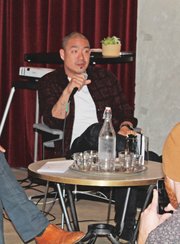TECHNOLOGY
Fashion and Tech Merge at Fi3
The intersection of fashion and technology—and the future of wearable technology—was on the agenda at a recent one-day conference hosted by Fi3.
Held in partnership with Apparel Insiders and sponsored by ISKO, the Oct. 13 conference at the Ace Hotel in downtown Los Angeles featured several speakers, including Sylvia Heisel, founder of Heisel Co.; Sandra Lopez, director business and marketing strategy, fashion wearable technology, for Intel Corp.; and Peter Kim, founder and chief executive officer of Hudson Jeans.
Last year, Intel founded its New Devices Group to better understand the world of wearables. Its focus is on emerging technologies because, as Sandra Lopez emphasized, “technology is in the forefront of bringing wearables to market.” Intel is not claiming to have started the wearable trend but has been granted a budget of $10 million for research and development. More recently, Intel’s New Devices Group has branched into the fashion and luxury sectors, using its wearable-technologies information to collaborate with Barneys New York and Opening Ceremony. Moving forward it is striving to strengthen the merging of technology and fashion.
Heisel, with a background in women’s luxury fashion design, established her firm last year with a focus on sustainability issues and how new technologies, such as new materials and new manufacturing, may be transforming and “disrupting” the industry.
Wearable technology is inevitably bound to disrupt the industry, Lopez said. She brought up the example of how technologies such as Airbnb and Uber have already disrupted the hotel and taxi industries, respectively.
Hudson’s Kim also discussed how companies such as Go Pro and Red Bull have structured their communications departments in a way that is revolutionizing customer connection beyond their industries.
According to Heisel, as early as the end of this year, retailers will implement “electronic tagging embedded in all merchandise that connects all their inventory. … There is also a program now where [companies] are starting to track the beginning stages of the fibers being made, or where the silkworm is in the world, all the way through the entire production process, all the way back to the consumer, so there is data and tracking and consumers will be educated and know where their purchases come from.”
Other examples that were brought up of ways imminent technology is foreseen to disrupt the market include 3-D printing and nano-coatings that do not change the appearance or feel of a fabric but, because they are essentially microchips embedded into the fibers, could eventually charge batteries and power devices.
“Our focus is on fabric because we are looking at wearable devices. Labs are looking for where can we extract energy, whether it be from solar or a consumer’s body, to generate power and extend battery life,” Lopez said.
Heisel also mentioned how scientists are feeding silkworms phosphorescent dyes. “The idea is that instead of dyeing the fabric, you feed the worms. They end up spinning silk in that color. It actually works and saves water and processing.”
Sportswear companies have already been using mapping technology to see how bodies move and how fabrics stretch and wear over time. Although they are still considered to be in the beginning stages of using “smart” fabric for mapping, the rest of the industry is on the brink of seeing more crossovers.
“If you look at kids now, they have had lights in their clothing their entire lives. Having clothes and shoes that blink is their normal,” Heisel said. “They are growing up with technology, so there is a different level of acceptance.”
True blue
Part of the conference focused on success stories and branding. Kim, who founded Hudson Jeans in 2002, attributes the company’s ongoing success to always “pushing for progress.” He said by never getting comfortable, not being afraid and accepting that change is inevitable, he was able to strengthen the DNA of his brand. He emphasized staying true to the company’s soul by staying authentic and hiring people who can not only get the job done well but also fit into the culture of the company.
“It is still a constant struggle to stay relevant in the premium-denim market,” he said. “Roughly seven to eight brands control around 80 percent of the market.”
Kim’s advice for brands that want to stay relevant is to stay passionate and evolve. “There is no going back,” he said. “What worked last year may be irrelevant by next year.”






















